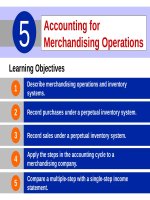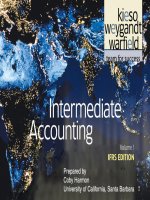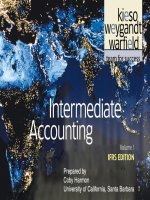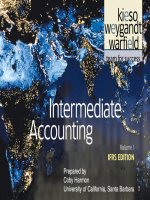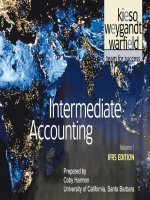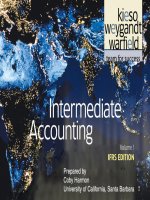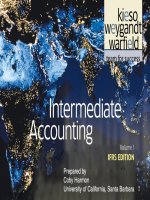Intermediate accounting volum 1 IFRS edition chapter 05
Bạn đang xem bản rút gọn của tài liệu. Xem và tải ngay bản đầy đủ của tài liệu tại đây (2.72 MB, 76 trang )
5-1
CHAPTER
5
STATEMENT OF FINANCIAL POSITION
AND STATEMENT OF CASH FLOWS
Intermediate Accounting
IFRS Edition
Kieso, Weygandt, and Warfield
5-2
Learning
Learning Objectives
Objectives
5-3
1.
Explain the uses and limitations of a statement of financial position.
2.
Identify the major classifications of the statement of financial position.
3.
Prepare a classified statement of financial position using the report
and account formats.
4.
Indicate the purpose of the statement of cash flows.
5.
Identify the content of the statement of cash flows.
6.
Prepare a basic statement of cash flows.
7.
Understand the usefulness of the statement of cash flows.
8.
Determine additional information requiring note disclosure.
9.
Describe the major disclosure techniques for financial statements.
Statement
Statement of
of Financial
Financial Position
Position
and
and Statement
Statement of
of Cash
Cash Flows
Flows
Statement of
Financial Position
Statement of Cash
Flows
Usefulness
Purpose
Notes
Limitations
Content and
format
Techniques of
disclosure
Preparation
Other guidelines
Classification
Usefulness
5-4
Additional
Information
Statement
Statement of
of Financial
Financial Position
Position
Statement of Financial Position, also referred to as the
balance sheet:
1. Reports assets, liabilities, and equity at a specific date.
2. Provides information about resources, obligations to
creditors, and equity in net resources.
3. Helps in predicting amounts, timing, and uncertainty of
future cash flows.
5-5
LO 1 Explain the uses and limitations of a statement of financial position.
Statement
Statement of
of Financial
Financial Position
Position
Usefulness
Computing rates of return.
Evaluating capital structure.
Assess risk and future cash flows.
Analyze company’s:
5-6
Liquidity
Solvency
Financial flexibility
LO 1 Explain the uses and limitations of a statement of financial position.
Statement
Statement of
of Financial
Financial Position
Position
Limitations
Most assets and liabilities are reported at historical
cost.
Use of judgments and estimates.
Many items of financial value are omitted.
5-7
LO 1 Explain the uses and limitations of a statement of financial position.
Statement
Statement of
of Financial
Financial Position
Position
Classification
5-8
LO 2 Identify the major classifications of the statement of financial position.
Statement
Statement of
of Financial
Financial Position
Position
Subclassifications
Illustration 5-1
In some countries, such as Germany, companies often list current assets first.
IAS No. 1 requires companies to distinguish current assets and liabilities from
non-current ones, except in limited situations.
5-9
LO 2 Identify the major classifications of the statement of financial position.
Classification
Classification
Non-Current Assets
Generally consists of:
Long-term Investments
Property, Plant, and Equipment
Intangibles Assets
Other Assets
5-10
LO 2 Identify the major classifications of the statement of financial position.
Classification
Classification
Non-Current Assets
Long-term Investments
1. Securities (bonds, ordinary shares, or long-term notes).
2. Tangible assets not currently used in operations (land held
for speculation).
3. Special funds (sinking fund, pension fund, or plant
expansion fund.
4. Non-consolidated subsidiaries or associated companies.
5-11
LO 2 Identify the major classifications of the statement of financial position.
Classification
Classification
Investments in Debt and Equity Securities
Portfolio
Type
Valuation
Classification
Held-forCollection
Debt
Amortized
Cost
Current or
Noncurrent
Trading
Debt or Equity
Fair Value
Current
Fair Value
Current or
Noncurrent
Non-Trading
Equity
5-12
Equity
LO 2 Identify the major classifications of the statement of financial position.
Classification
Classification
Long-Term Investments
Illustration 5-2
Statement of Financial
Position Presentation of
Long-Term Investments
5-13
LO 2 Identify the major classifications of the statement of financial position.
Classification
Classification
Property, Plant, and Equipment
Tangible long-lived assets used in the regular operations
of the business.
Physical property such as land, buildings, machinery,
furniture, tools, and wasting resources (minerals).
With the exception of land, a company either depreciates
(e.g., buildings) or depletes (e.g., oil reserves) these
assets.
5-14
LO 2 Identify the major classifications of the statement of financial position.
Classification
Classification
Illustration 5-3
Statement of Financial Position
Presentation of Property, Plant,
and Equipment
5-15
LO 2 Identify the major classifications of the statement of financial position.
Classification
Classification
Intangible Assets
Lack physical substance and are not financial
instruments.
Patents, copyrights, franchises, goodwill, trademarks,
trade names, and customer lists.
Amortize limited-life intangible assets over their useful
lives.
Periodically assess indefinite-life intangibles for
impairment.
5-16
LO 2 Identify the major classifications of the statement of financial position.
Classification
Classification
Intangible Assets
Illustration 5-4
Statement of Financial
Position Presentation of
Intangible Assets
5-17
LO 2 Identify the major classifications of the statement of financial position.
Classification
Classification
Other Assets
Items vary in practice. Can include:
Long-term prepaid expenses
Non-current receivables
Assets in special funds
Property held for sale
Restricted cash or securities
5-18
LO 2 Identify the major classifications of the statement of financial position.
Classification
Classification
Current Assets
Cash and other assets a company expects to convert
into cash, sell, or consume either in one year or in the
operating cycle, whichever is longer.
Illustration 5-5
5-19
LO 2 Identify the major classifications of the statement of financial position.
Classification
Classification
Inventories
Disclose:
Basis of valuation (e.g., lower-of-cost-or-market).
Cost flow assumption (e.g., FIFO or average cost).
Illustration 5-6
5-20
LO 2
Classification
Classification
Inventories
Manufacturing Company
Illustration 5-8
Statement of Financial Position
Presentation of Inventories
5-21
LO 2
Classification
Classification
Receivables
Claims held against customers and others for
money,
goods, or
services.
Major categories of receivables should be shown in the
statement of financial position or the related notes.
5-22
LO 2 Identify the major classifications of the statement of financial position.
Classification
Classification
Receivables
Illustration 5-8
Statement of Financial Position
Presentation of Receivables
5-23
LO 2 Identify the major classifications of the statement of financial position.
Classification
Classification
Prepaid Expenses
Payment of cash, that is recorded as an asset because
service or benefit will be received in the future.
Cash Payment
BEFORE
Expense Recorded
Prepayments often occur in regard to:
insurance
supplies
advertising
5-24
rent
maintenance on equipment
LO 2 Identify the major classifications of the statement of financial position.
Classification
Classification
Prepaid Expenses
5-25
Illustration 5-9
Statement of Financial Position
Presentation of Prepaid Expenses
LO 2



